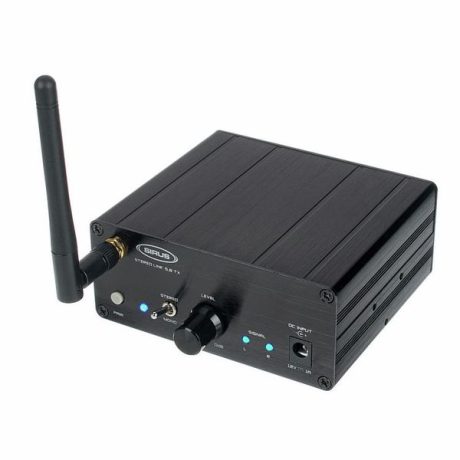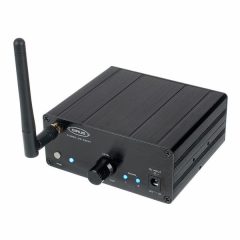| Content |
The Symphony I/O Chassis from Apogee provides two I/O Module slots for a variety of digital audio conversion options that form the interface side of the Symphony I/O. Elegant and easy to use, the front panel of Symphony I/O Chassis presents the visual feedback needed to monitor levels, sample rate and clock status, along with the controls required to adjust gain, output levels ,and select the Audio Interface Mode (AIM).
The rear panel provides access to the two I/O Module slots that are capable of a combined thirty-two channels of input and output. PCI, USB and Ethernet connectivity ensures complete compatibility with popular workstations, while the panel also includes Wordclock I/O connectors and termination, LoopSynch I/O connectors, and a quiet digitally-controlled fan to keep everything running cool.
The Audio Interface Mode (AIM) allows the system to be optimized for the most popular audio workstation environments, including Symphony PCI, Pro Tools HD PCI, USB audio, or to function as a standalone converter. With a two-step adjustment using a single front panel encoder knob, the interface can be easily switched back and forth between the preferred modes.
The optional five I/O Modules allow the user to choose from standard configurations, or customize the following - channel count, analog to digital input, digital to analog output, microphone preamps (requires an analog card) and digital I/O.
Two input/output module slots Ethernet connector USB 2.0 connector Two Symphony PC-32 ports for direct connection to Symphony 64 PCI card and Pro Tools core card Wordclock I/O and LoopSync I/O Wordclock termination switch Sixteen, 10-segment meters Two multi-function encoder knobs OLED GUI provides function selection and function adjustment and Audio Interface Mode (AIM) selection Two 1/4" headphone outputs 7-segment sample rate display Clock source display Meter source display High-performance, temperature controlled fan Connectors 2 x 1/4" TRS phone Headphone
2 x Symphony I/O PC-32 Ports
1 x Ethernet
1 x USB
2 x BNC Wordclock I/O
2 x BNC LoopSync I/O
Headphones THD+N: -105dB @ 19dBu
Dynamic Range: 119dB, A-weighted
Output Impedance: 30Ω
Power Requirements 90~240VAC, 50/60Hz, 150W
System Requirements Mac OS X 10.5.8 and above
Dimensions (WxDxH) 19 x 11.5 x 3.5" (483 x 292 x 89mm)
|
Wireless 5.8 GHz Stereo Transmitter
- For wireless transmission of a stereo audio signal
- Maximum range: 30 m
- One transmitter can be paired with up to 8 receivers
- Inputs: 2x XLR female or 2x 6.3 mm jack (unbalanced)
- Switch for mono/stereo operation
- Volume control
- Dimensions without antenna (L x W x H): 115 x 105 x 45 mm
- Includes external power supply DC 12 V / 1 A (plus inside) and mounting bracket
|
For decades, dbx’s patented Subharmonic Synthesis has rattled foundations enhancing the bass in a variety of professional applications including nightclub and DJ mixing, theatre and film sound, music recording, live music performance and broadcasting. dbx’s Subharmonic Synthesis process actually produces a new, Waveform Modeled bass note, exactly an octave below the bass in the original audio.
The dbx 510 answers the call of audio professionals everywhere delivering Subharmonic Synthesis in the convenient design of a 500 Series module. The 510’s two separate bands of subharmonic synthesis provide the best combination of smoothness and control, while the independent Low Frequency Boost circuit is designed to get the most out of high-performance, low frequency speaker systems. Unlike other attempts at bass synthesis, the dbx process produces musical low frequencies that don’t interfere with mid and high-band information, even when the maximum synthesis and boost are applied. The result is a low-end punch that people really feel!
Put some boom in your room with the dbx 510! | The dbx 520 will help you expertly tame the excessive sibilance often found in vocals and other high frequency dense material. Based upon the legendary dbx 902, the dbx 520’s unique features make it possible to achieve an exact amount of de-essing regardless of variations in signal levels. The 520 allows you to create brilliant, crisp vocals without sibilance!
With its modular 500 Series based design, the dbx 520 examines the differences in dB between the high frequency and full-bandwidth portions of a signal, allowing de-essing of signals which change in level by as much as 60dB. It features a Frequency Control with range from 800Hz to 8kHz, Gain Reduction Metering and a De-essing Amount Range from 0dB to 20dB.
Control vocals, drums, percussive instruments and problematic material/reverb combinations with the dbx 520! |
Κάρτα τεσσάρων εξόδων line για τα BLU-80, BLU-32, BLU-16.
|
The Soundweb London BLU-101 offers a fixed configuration of 12 analog inputs and 8 analog outputs, configurable signal processing, AEC processing, and a high bandwidth, fault tolerant digital audio bus.
The BLU-101 has open architecture which is fully configurable through HiQnet™ London Architect. A rich palette of processing and logic objects and a "drag and drop” method of configuration provide a simple and familiar design environment.
The BLU-101 contains dedicated AEC processing for up to 12 independent AEC algorithms. The AEC algorithm can be applied to signals coming from the local analog inputs or from the digital audio bus. 12 individual AEC references (one per algorithm) allow the user to provide a solution for multiple conferencing spaces using a single device.
Automatic Gain Control (AGC) and Noise Cancellation (NC) are also provided per AEC algorithm. AGC ensures that microphone levels remain at an optimum level, and NC removes steady state noise (such as from a projector fan or air conditioning device) from the signal path.
This processor features a low latency, fault tolerant digital audio bus of 48 channels which uses standard Category 5e cabling giving a distance of 100m between compatible devices. Fiber media converters can be used to increase the distance between devices to over 40km.
The BLU-101 is compatible with the entire Soundweb London family and its 48 channel digital audio bus represents channels 1-48 of the larger 256 channel digital audio bus when integrated with the BLU-800, BLU-320, BLU-160, BLU-120, BLU-BIB and BLU-BOB devices.
Analog Inputs provide software configurable gain in 6dB steps up to +48dB per channel and software selectable Phantom Power per channel.
Phantom Power, Signal Present and Clip information per channel is easily accessible, without the requirement for a PC, from clear front panel LED indication. A bi-directional locate function allows devices to be identified both from and within HiQnet London Architect.
12 Control Inputs and 6 Logic Outputs allow the BLU-101 to be integrated with GPIO compatible devices. The Soundweb London Interface Kit, comprehensive documentation which details how Soundweb London systems can be integrated with third party control systems, is included within the installation of HiQnet London Architect.
The BLU-101 and the other members of the Soundweb London family provide the building blocks of the perfectly tailored system solution.
Key Features:
• 12 Analog Inputs (with 48v Phantom Power per Channel)
• 8 Analog Outputs
• Configurable Signal Processing
• 12 Channels of AEC Processing with Auto Gain Control and Noise Cancellation
• Rich Palette of Processing and Logic Objects
• 48 Channel, Low Latency, Fault Tolerant Digital Audio Bus
• Clear Front Panel LED Indication
• Bi-Directional Locate Functionality
• 12 Control Inputs and 6 Logic Outputs for GPIO Integration
• Soundweb London Interface Kit for Third Party Control System Integration (Documentation)
• HiQnet Device
• Configuration, Control and Monitoring from HiQnet London Architect |

















Reviews
There are no reviews yet.